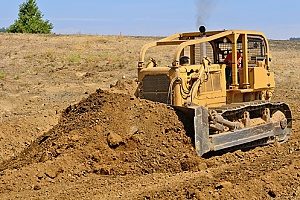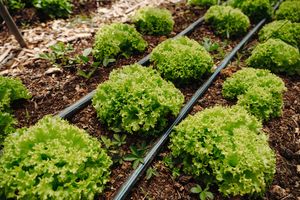Mastering Field Leveling: Secrets to Optimal Crop Growth and Efficiency
 To achieve the best crop growth and efficiency, start by mastering field leveling. A well-leveled field is essential for successful farming, helping with proper water drainage, nutrient distribution, and plant root development. In this article, we will explore key techniques and strategies for field leveling that can help farmers and growers maximize their yields and improve overall crop quality.
To achieve the best crop growth and efficiency, start by mastering field leveling. A well-leveled field is essential for successful farming, helping with proper water drainage, nutrient distribution, and plant root development. In this article, we will explore key techniques and strategies for field leveling that can help farmers and growers maximize their yields and improve overall crop quality.
Importance of Field Leveling in Crop Growth
Field leveling is a vital practice in modern agriculture. It helps optimize crop growth and boosts farm productivity. By creating an even surface, field leveling ensures efficient water management and proper root development for crops.
One major benefit of a well-leveled field is better water drainage. Uneven fields can cause water to pool in low spots, leading to waterlogged soil and poor plant growth. This can reduce crop yields and make plants more prone to disease. On the other hand, a leveled field allows for even water distribution, giving all plants the moisture they need for optimal growth.
Common Challenges in Field Leveling
 Field leveling can be challenging, especially in areas with uneven terrain or different soil types. One common issue is dealing with slopes or obstacles like rocks and tree stumps, which can make leveling difficult. Removing these obstacles requires time, labor, and the right equipment.
Field leveling can be challenging, especially in areas with uneven terrain or different soil types. One common issue is dealing with slopes or obstacles like rocks and tree stumps, which can make leveling difficult. Removing these obstacles requires time, labor, and the right equipment.
Soil type also plays a role in field leveling. Clay-rich soils or soils with poor drainage can be harder to level. These soils may compact easily or become waterlogged. On the other hand, sandy soils might need different techniques to ensure a stable surface.
Weather can also affect the leveling process. Heavy rain or drought can change soil moisture levels, which are crucial for successful leveling. Adjusting to these conditions requires flexibility and a good understanding of field leveling techniques.
Tools and Techniques for Field Leveling
Advancements in technology have made land grading more precise and efficient. One popular method is laser leveling, which uses a laser-guided system to create a perfectly even surface.
In this process, a laser transmitter emits a beam of light detected by a receiver on a grading tool like a scraper or bulldozer. This system allows for precise adjustments, ensuring the soil is evenly distributed.
Another advanced technique is GPS-guided grading. This method uses GPS technology to map the terrain and create a detailed topographic model. The information is then used to guide a tractor or leveling tool, ensuring a consistent surface.
Traditional methods, like manual grading with shovels or using a tractor-mounted land plane, can also be effective. While these approaches may take more time and effort, they are useful for fine-tuning or addressing smaller, more challenging areas.
Benefits of Optimal Land Grading
 Achieving optimal land grading brings many benefits, including higher crop yields, better resource efficiency, and increased farm profitability.
Achieving optimal land grading brings many benefits, including higher crop yields, better resource efficiency, and increased farm profitability.
One key advantage is improved water management. A properly leveled field ensures even water distribution, reducing the risk of waterlogging or drought-prone areas. This leads to better root development, more efficient nutrient uptake, and ultimately, higher crop yields.
Effective land grading also enhances nutrient management. When the soil is evenly distributed, fertilizers and amendments are applied uniformly, ensuring all plants receive the nutrients they need. This boosts crop productivity and reduces the risk of nutrient runoff.
Additionally, a smooth, even surface improves the efficiency of farm machinery. Tractors, planters, and harvesters operate better on well-graded fields, reducing fuel consumption and wear and tear on equipment.
Factors to Consider Before Land Grading
 Before starting a grading project, consider factors like soil characteristics, topography, drainage patterns, and environmental conditions.
Before starting a grading project, consider factors like soil characteristics, topography, drainage patterns, and environmental conditions.
Soil composition is crucial because different types require varying techniques. Clay-rich soils may need specialized equipment, while sandy soils might require different methods to prevent erosion.
Topography, or the land’s shape, also matters. Gently sloping terrain is easier to grade, while areas with steep slopes may require more extensive work.
Proper drainage is another key factor. Fields need adequate systems to prevent waterlogging. Without sufficient drainage, the graded surface may become unstable, leading to erosion and poor crop growth.
Step-by-Step Guide to Land Grading
To successfully level your land, follow these steps:
-
- Assess the Land: Evaluate the area’s topography, soil, and drainage. Identify obstacles or problem areas.
- Develop a Plan: Create a detailed plan outlining your goals, the necessary equipment, and a timeline.
- Prepare the Area: Remove obstacles like rocks or debris. Address any drainage issues.
- Grade the Land: Use the appropriate tools and techniques, like laser-guided or GPS-guided systems, to shape the terrain.
- Compact the Soil: After grading, compact the soil with a roller to ensure a stable surface.
- Verify the Results: Inspect the area to ensure it meets your goals. Make any needed adjustments.
- Maintain the Land: Regularly check for erosion or settling. Keep up with soil management to preserve the even surface.
Best Practices for Maintaining Field Leveling
Maintaining a leveled field is crucial for long-term success. Regularly inspect the field for signs of erosion or uneven areas. Address issues quickly to prevent further damage.
Use conservation tillage practices, like no-till farming, to minimize soil disturbance and keep the field level. Adding organic matter to the soil can also improve its structure and stability.
Effective water management is essential. Make sure drainage systems are working properly, and clean out ditches or tiles regularly to prevent water from pooling.
Consider crop rotation and cover cropping to maintain soil health and reduce erosion. These practices can help preserve the benefits of field leveling over time.
Case Studies of Successful Field Leveling
 Let’s look at some real-life examples of successful field leveling:
Let’s look at some real-life examples of successful field leveling:
- California’s Central Valley: A vegetable farm used precision laser leveling to solve water management issues, boosting crop yields by 20%.
- Midwest Grain Farm: A family farm adopted GPS-guided leveling, reducing fuel consumption by 12% and increasing crop yields by 17%.
- Pacific Northwest Farm: A diversified farm combined laser leveling with traditional methods, reducing soil erosion by 25% and increasing crop production by 18%.
These case studies show how effective field leveling can lead to better resource efficiency, higher yields, and long-term sustainability.
How to Choose the Right Field Leveling Equipment
Choosing the right field leveling equipment is crucial for a successful project. Consider the size and type of your field, as well as the soil conditions. For large fields with uneven terrain, GPS-guided machinery or laser leveling systems are ideal. These technologies provide precision, ensuring a smooth and even surface. On smaller plots, traditional methods like tractor-mounted land planes may be more cost-effective. Additionally, consider the type of soil. Clay-rich soils may require heavier equipment, while sandy soils might need specialized tools to prevent erosion. By selecting the appropriate field leveling tools, you can achieve the best results for your specific needs.
Cost Considerations for Field Leveling Projects
 Understanding the costs involved in a field leveling project is essential for proper budgeting. Costs can vary depending on the size of the field, the type of equipment used, and the complexity of the terrain. High-tech solutions like GPS-guided systems may have higher upfront costs but can save money in the long run by improving efficiency. On the other hand, manual methods might be cheaper initially but could require more labor and time. Don’t forget to account for potential hidden costs, such as soil amendments or drainage improvements. By carefully planning your budget, you can ensure that your field leveling project stays on track financially.
Understanding the costs involved in a field leveling project is essential for proper budgeting. Costs can vary depending on the size of the field, the type of equipment used, and the complexity of the terrain. High-tech solutions like GPS-guided systems may have higher upfront costs but can save money in the long run by improving efficiency. On the other hand, manual methods might be cheaper initially but could require more labor and time. Don’t forget to account for potential hidden costs, such as soil amendments or drainage improvements. By carefully planning your budget, you can ensure that your field leveling project stays on track financially.
Environmental Impact of Field Leveling
Field leveling has significant environmental benefits when done correctly. By creating a smooth and even surface, you can reduce soil erosion and improve water management. This leads to better nutrient retention in the soil and helps prevent runoff, which can be harmful to nearby water sources. However, it’s important to consider the potential negative impacts, such as soil compaction or disturbance of natural habitats. To minimize these effects, use sustainable practices like conservation tillage and incorporate organic matter into the soil. By focusing on the environmental aspects of field leveling, you can contribute to more sustainable and eco-friendly farming practices.
Field Leveling for Different Crop Types
 Field leveling techniques can vary depending on the crop being grown. For example, crops like rice, which require flooded fields, need extremely precise leveling to ensure even water distribution. In contrast, root crops like potatoes benefit from slight slope adjustments to prevent waterlogging. Grains such as wheat or corn generally require broad, even surfaces to maximize yields. Understanding the specific needs of your crops can help you choose the right leveling method and equipment. By tailoring your field leveling approach to the crops you are growing, you can enhance both yield and quality.
Field leveling techniques can vary depending on the crop being grown. For example, crops like rice, which require flooded fields, need extremely precise leveling to ensure even water distribution. In contrast, root crops like potatoes benefit from slight slope adjustments to prevent waterlogging. Grains such as wheat or corn generally require broad, even surfaces to maximize yields. Understanding the specific needs of your crops can help you choose the right leveling method and equipment. By tailoring your field leveling approach to the crops you are growing, you can enhance both yield and quality.
Safety Tips for Field Leveling Operations
Safety should always be a top priority during field leveling operations. Begin by ensuring all equipment is in good working order and that operators are properly trained. Wear appropriate protective gear, such as gloves and safety glasses, to prevent injuries. Be mindful of obstacles like rocks and tree stumps that could pose a hazard. It’s also important to consider weather conditions; avoid leveling during heavy rain or extreme heat to reduce risks. By following these safety tips, you can ensure a smooth and accident-free field leveling process.
Troubleshooting Common Field Leveling Issues
 Even with careful planning, field leveling projects can encounter issues. One common problem is uneven compaction, which can lead to water pooling in certain areas. To fix this, re-level the affected sections and compact the soil properly. Another issue is the presence of hidden obstacles, like rocks or roots, that can disrupt the leveling process. Removing these obstacles early on can prevent delays. Additionally, if you notice erosion after leveling, consider implementing better drainage solutions. By addressing these issues promptly, you can maintain a level field that supports optimal crop growth.
Even with careful planning, field leveling projects can encounter issues. One common problem is uneven compaction, which can lead to water pooling in certain areas. To fix this, re-level the affected sections and compact the soil properly. Another issue is the presence of hidden obstacles, like rocks or roots, that can disrupt the leveling process. Removing these obstacles early on can prevent delays. Additionally, if you notice erosion after leveling, consider implementing better drainage solutions. By addressing these issues promptly, you can maintain a level field that supports optimal crop growth.
The Role of Soil Testing in Field Leveling
Soil testing is a critical step in the field leveling process. Before starting any leveling work, test the soil to understand its composition, pH level, and nutrient content. This information helps you choose the right leveling techniques and soil amendments. For example, clay-heavy soils might require more organic matter to improve drainage, while sandy soils may need stabilizers to prevent erosion. Regular soil testing after leveling is also important to monitor changes and make adjustments as needed. By incorporating soil testing into your field leveling strategy, you can create a more stable and productive agricultural environment
Seasonal Timing for Field Leveling
The timing of your field leveling project can greatly impact its success. Ideally, field leveling should be done during dry seasons when the soil is easier to work with and less prone to compaction. In regions with distinct wet and dry seasons, plan your leveling activities after the wet season to avoid delays caused by muddy conditions. Consider the crop cycle as well; leveling should be completed before planting begins to ensure a smooth start for your crops. By choosing the right time of year for field leveling, you can achieve better results and minimize disruptions to your farming schedule.
Integrating Field Leveling with Other Land Management Practices
Field leveling should be part of a broader land management strategy. Integrating it with practices like crop rotation, cover cropping, and conservation tillage can enhance the benefits of leveling. For example, rotating crops helps maintain soil fertility, while cover crops protect against erosion on newly leveled fields. Conservation tillage minimizes soil disturbance, preserving the level surface you’ve worked hard to achieve. By combining field leveling with these practices, you can create a more resilient and productive farming system.
Field Leveling for Irrigation Efficiency
 One of the primary benefits of field leveling is improved irrigation efficiency. A level field ensures that water is distributed evenly, reducing the risk of overwatering in some areas and underwatering in others. This is particularly important in regions where water resources are limited. By combining field leveling with efficient irrigation systems, such as drip or sprinkler irrigation, you can further optimize water use. This not only conserves water but also promotes healthier plant growth and higher yields. By focusing on irrigation efficiency, you can maximize the benefits of your field leveling efforts.
One of the primary benefits of field leveling is improved irrigation efficiency. A level field ensures that water is distributed evenly, reducing the risk of overwatering in some areas and underwatering in others. This is particularly important in regions where water resources are limited. By combining field leveling with efficient irrigation systems, such as drip or sprinkler irrigation, you can further optimize water use. This not only conserves water but also promotes healthier plant growth and higher yields. By focusing on irrigation efficiency, you can maximize the benefits of your field leveling efforts.
Future Prospects of Field Leveling in Agriculture
Field leveling is a key strategy for optimizing crop growth and improving farm efficiency. By using the latest technologies and best practices, farmers can achieve exceptional crop yields and sustainable farming.
As agriculture continues to evolve, the importance of field leveling will only grow. With advancements in precision agriculture, including AI and machine learning, field leveling systems will become even more precise, allowing for greater optimization.
Field leveling also has significant environmental benefits. It improves water management, reduces soil erosion, and promotes efficient nutrient use, all of which contributes to more sustainable farming practices.
Mastering field leveling is not a one-time task but an ongoing process. By staying informed and adopting new technologies, farmers can unlock the secrets to optimal crop growth and ensure long-term success.
Transform Your Property with Expert Land Improvement Services in Maryland, Virginia, and Washington DC
At Dirt Connections, we specialize in transforming your land into a functional and beautiful space. Whether you need forest paths cleared, gravel roads constructed, or bush hogging to maintain your property, our team has the expertise and equipment to handle it all. We also offer professional grading and forestry mulching services to ensure your land is level, well-maintained, and ready for any project. Serving the Maryland, Virginia, and Washington DC metro area, we are committed to delivering top-notch results that meet your specific needs. Let us help you enhance your property’s value and usability with our comprehensive land improvement services.
Summary

Dirt Connections was started with one goal in mind: providing quality residential and commercial construction services to clients on time and on budget. Reach out for more information on how we can support your next project.
For your convenience our estimates are free and by appointment. Call 703-940-9949 for a free estimate today!













































